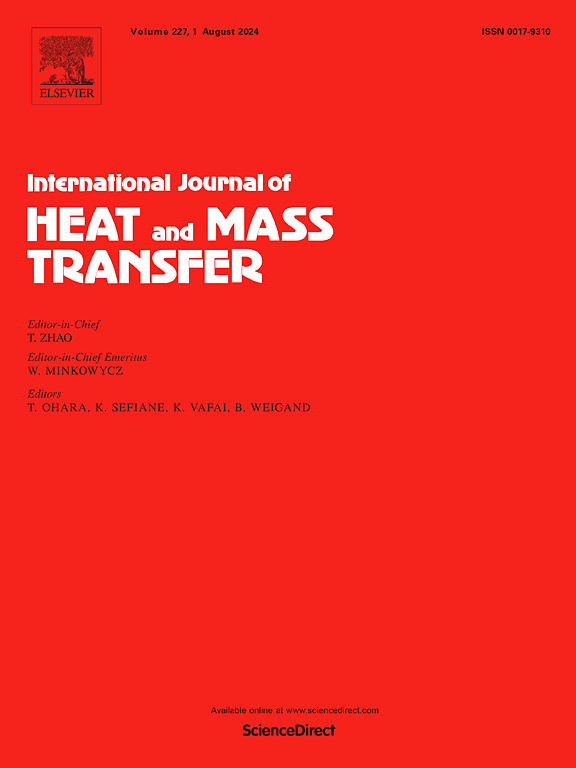Analytical solutions for mass transfer and hydrodynamic dispersion by electroosmotic flow of viscoelastic fluids in heterogeneous microchannels
IF 5.8
2区 工程技术
Q1 ENGINEERING, MECHANICAL
International Journal of Heat and Mass Transfer
Pub Date : 2025-05-05
DOI:10.1016/j.ijheatmasstransfer.2025.127165
引用次数: 0
Abstract
Consideration is given to the hydrodynamic dispersion of a very thin solute band of arbitrary height by the steady and fully-developed electroosmotic flow (EOF) in parallel-plate microchannels with asymmetric wall zeta potentials. This is meant to be a model for sample transfer by EOF in rectangular glass-PDMS microchannels for which there is a non-uniform distribution of the zeta potential due to surface heterogeneity. The side-wall effects are ignored for better mathematical tractability, which is a reasonable assumption given that glass-PDMS microchannels are usually shallow and the processes taking place in these microchannels take short. Given the fact that many working fluids in microfluidic devices are biofluids with complex rheology, the simplified Phan-Thien-Tanner (sPTT) viscoelastic rheological model is used for better applicability of the results to real-life problems. Adopting the generalized dispersion theory and assuming the zeta potentials to be low enough to allow applying the Debye-Hückel approximation, analytical solutions are obtained for the convection and dispersion coefficients as well as for the mean and local concentrations. The results indicate that while asymmetry significantly increases the dispersion coefficient for thin electric double layers it may slightly decrease the dispersion for very thick double layers. Moreover, the viscoelasticity is found to drastically amplify the hydrodynamic dispersion, which highlights the importance of considering non-linear rheology in the pertinent simulations. Finally, complicated variations of the dispersion coefficient are observed with the relative double layer thickness, sometimes with local minimums, indicating the feasibility of minimizing the dispersion of solutes by adjusting the channel height.
非均质微通道中粘弹性流体电渗透传质和流体动力分散的解析解
考虑了具有不对称壁电位的平行板微通道中稳定且充分发展的电渗透流(EOF)对任意高度的极薄溶质带的水动力分散。这意味着在矩形玻璃- pdms微通道中通过EOF转移样品的模型,由于表面非均匀性,zeta电位分布不均匀。为了更好的数学可跟踪性,忽略了侧壁效应,这是一个合理的假设,因为玻璃- pdms微通道通常很浅,并且在这些微通道中发生的过程需要很短的时间。考虑到微流控装置中的许多工作流体都是具有复杂流变特性的生物流体,为了使结果更好地适用于实际问题,采用了简化的Phan-Thien-Tanner (sPTT)粘弹性流变模型。采用广义色散理论,假设zeta势足够低,可以应用debye - h ckel近似,得到对流系数和色散系数以及平均浓度和局部浓度的解析解。结果表明,不对称对薄双电层的色散系数有显著提高,对厚双电层的色散系数有轻微降低。此外,粘弹性极大地放大了流体动力分散,这突出了在相关模拟中考虑非线性流变的重要性。最后,观察到色散系数随相对双层厚度的复杂变化,有时出现局部最小值,表明通过调节通道高度来最小化溶质色散的可行性。
本文章由计算机程序翻译,如有差异,请以英文原文为准。
求助全文
约1分钟内获得全文
求助全文
来源期刊
CiteScore
10.30
自引率
13.50%
发文量
1319
审稿时长
41 days
期刊介绍:
International Journal of Heat and Mass Transfer is the vehicle for the exchange of basic ideas in heat and mass transfer between research workers and engineers throughout the world. It focuses on both analytical and experimental research, with an emphasis on contributions which increase the basic understanding of transfer processes and their application to engineering problems.
Topics include:
-New methods of measuring and/or correlating transport-property data
-Energy engineering
-Environmental applications of heat and/or mass transfer

 求助内容:
求助内容: 应助结果提醒方式:
应助结果提醒方式:


